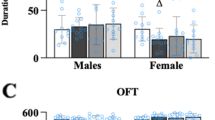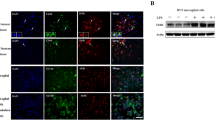Abstract
Neuroinflammation is involved in a wide range of brain disorders, thus there is great interest in identifying novel anti-inflammatory agents to include in therapeutic strategies. Our previous in vitro studies revealed that beta-funaltrexamine (β-FNA), a well-characterized selective mu-opioid receptor (MOR) antagonist, inhibits inflammatory signaling in human astroglial cells, albeit through an apparent MOR-independent mechanism. We also previously determined that lipopolysaccharide (LPS)-induced sickness behavior and neuroinflammation in mice are prevented by pretreatment with β-FNA. Herein we investigated the temporal importance of β-FNA treatment in this pre-clinical model of LPS-induced neuroinflammation. Adult, male C57BL/6J mice were administered an i.p. injection of LPS followed by treatment (i.p. injection) with β-FNA immediately or 4 h post-LPS. Sickness behavior was assessed using an open-field test, followed by assessment of inflammatory signaling in the brain, spleen, and plasma. Levels of inflammatory chemokines/cytokines (interferon γ-induced protein, CXCL10; monocyte chemotactic protein 1, CCL2; and interleukin-6, IL-6) in tissues were measured using an enzyme-linked immunosorbent assay and nuclear factor-kappa B (NFκB), p38 mitogen activated kinase (p38 MAPK), and glial fibrillary acidic protein (GFAP) expression were measured by western blot. LPS-induced sickness behavior and chemokine expression were inhibited more effectively when β-FNA treatment occurred immediately after LPS administration, as opposed to 4 h post-LPS; and β-FNA-mediated effects were time-dependent as evidenced by inhibition at 24 h, but not at 8 h. The inhibitory effects of β-FNA on chemokine expression were more evident in the brain versus the spleen or plasma. LPS-induced NFκB-p65 and p38 MAPK expression in the brain and spleen were inhibited at 8 and 24 h post-LPS. These findings extend our understanding of the anti-inflammatory effects of β-FNA and warrant further investigation into its therapeutic potential.







Similar content being viewed by others
Data availability
Data will be made available for review as needed upon legitimate request.
References
Bai YM, Su TP, Li CT, Tsai SJ, Chen MH, Tu PC, Chiou WF (2015) Comparison of pro-inflammatory cytokines among patients with bipolar disorder and unipolar depression and normal controls. Bipolar Disord 17:269–277
Betteridge JD et al (2013) Inflammatory bowel disease prevalence by age, gender, race, and geographic location in the US military health care population. Inflamm Bowel Dis 19(7):1421–1427
Blank T, Detje CN, Spieß A, Hagemeyer N, Brendecke SM, Wolfart J, Staszewski O, Zöller T, Papageorgiou I, Schneider J, Paricio-Montesinos R, Eisel UL, Manahan-Vaughan D, Jansen S, Lienenklaus S, Lu B, Imai Y, Müller M, Goelz SE, Baker DP, Schwaninger M, Kann O, Heikenwalder M, Kalinke U, Prinz M (2016) Brain endothelial- and epithelial-specific interferon receptor chain 1 drives virus-induced sickness behavior and cognitive impairment. Immunity 44:901–912
Burton MD, Sparkman NL, Johnson RW (2011) Inhibition of interleukin-6 trans-signaling in the brain facilitates recovery from lipopolysaccharide-induced sickness behavior. J Neuroinflamm 8:54
Da Ré C, Souza JM, Fróes F, Taday J, Dos Santos JP, Rodrigues L, Sesterheim P, Gonçalves CA, Leite MC (2020) Neuroinflammation induced by lipopolysaccharide leads to memory impairment and alterations in hippocampal leptin signaling. Behav Brain Res 379:112360
Dantzer R (2001) Cytokine-induced sickness behavior: mechanisms and implications. Ann N Y Acad Sci 933:222–234
Davis RL, Dertien J, Syapin PJ (2002) Ethanol-induced modulation of inducible nitric-oxide synthase activity in human A172 astrocytoma cells. Alcohol Clin Exp Res 26:1404–1411
Davis RL, Buck DJ, Saffarian N, Stevens CW (2007) The opioid antagonist, beta-funaltrexamine, inhibits chemokine expression in human astroglial cells. J Neuroimmunol 186:141–149
Davis RL, Buck DJ, Saffarian N, Mohan S, DeSilva U, Fernando SC, Stevens CW (2008) Beta-funaltrexamine inhibits inducible nitric-oxide synthase expression in human astroglial cells. J Neuroimmune Pharmacol 3:150–153
Davis RL, Das S, Buck DJ, Stevens CW (2013) β-funaltrexamine inhibits chemokine (CXCL10) expression in normal human astrocytes. Neurochem Int 62:478–485
Davis RL, Das S, Thomas Curtis J, Stevens CW (2015) The opioid antagonist, β-funaltrexamine, inhibits NF-κB signaling and chemokine expression in human astrocytes and in mice. Eur J Pharmacol 762:193–201
Davis RL, Stevens CW, Thomas Curtis J (2017) The opioid antagonist, beta-funaltrexamine, inhibits lipopolysaccharide-induced neuroinflammation and reduces sickness behavior in mice. Physiol Behav 173:52–60
Davis RL, McCracken K, Buck DJ (2020) β-funaltrexamine differentially modulates chemokine and cytokine expression in normal human astrocytes and C20 human microglial cells. Neuroimmunol Neuroinflamm 7:300–310
Glass CK, Saijo K, Winner B, Marchetto MC, Gage FH (2010) Mechanisms underlying inflammation in neurodegeneration. Cell 140:918–934
He P, Yan S, Zheng J, Gao Y, Zhang S, Liu Z, Liu X, Xiao C (2018) Eriodictyol attenuates LPS-induced neuroinflammation, amyloidogenesis, and cognitive impairments via the inhibition of NF-κB in male C57BL/6J mice and BV2 microglial cells. J Agric Food Chem 66:10205–10214
Ifuku M, Katafuchi T, Mawatari S, Noda M, Miake K, Sugiyama M, Fujino T (2012) Anti-inflammatory/anti-amyloidogenic effects of plasmalogens in lipopolysaccharide-induced neuroinflammation in adult mice. J Neuroinflamm 9:197
Khansari PS, Sperlagh B (2012) Inflammation in neurological and psychiatric diseases. Inflammopharmacology 20:103–107
Kolb SA, Sporer B, Lahrtz F, Koedel U, Pfister HW, Fontana A (1999) Identification of a T cell chemotactic factor in the cerebrospinal fluid of HIV-1-infected individuals as interferon-gamma inducible protein 10. J Neuroimmunol 93:172–181
Kwon HS, Koh SH (2020) Neuroinflammation in neurodegenerative disorders: the roles of microglia and astrocytes. Transl Neurodegener 9:42
Lasselin J, Elsenbruch S, Lekander M, Axelsson J, Karshikoff B, Grigoleit JS, Engler H, Schedlowski M, Benson S (2016) Mood disturbance during experimental endotoxemia: predictors of state anxiety as a psychological component of sickness behavior. Brain Behav Immun 57:30–37
Le Thuc O, Cansell C, Bourourou M, Denis RG, Stobbe K, Devaux N, Guyon A, Cazareth J, Heurteaux C, Rostène W, Luquet S, Blondeau N, Nahon JL, Rovère C (2016) Central CCL2 signaling onto MCH neurons mediates metabolic and behavioral adaptation to inflammation. EMBO Rep 17:1738–1752
Na S, Duan X, Wang R, Fan Y, Xue K, Tian S, Yang Z, Li K, Yue J (2021) Chronic neuroinflammation induced by lipopolysaccharide injection into the third ventricle induces behavioral changes. J Mol Neurosci 71:1306–1319
Patki G, Solanki N, Atrooz F, Allam F, Salim S (2013) Depression, anxiety-like behavior and memory impairment are associated with increased oxidative stress and inflammation in a rat model of social stress. Brain Res 1539:73–86
Ramachandra V, Kang F, Kim C, Nova AS, Bajaj A, Hall FS, Uhl GR, Gonzales RA (2011) The μ opioid receptor is not involved in ethanol-stimulated dopamine release in the ventral striatum of C57BL/6J mice. Alcohol Clin Exp Res 35:929–938
Salazar A, Gonzalez-Rivera BL, Redus L, Parrott JM, O’Connor JC (2012) Indoleamine 2,3-dioxygenase mediates anhedonia and anxiety-like behaviors caused by peripheral lipopolysaccharide immune challenge. Horm Behav 62:202–209
Shah MA, Park DJ, Kang JB, Kim MO, Koh PO (2020) Baicalin alleviates lipopolysaccharide-induced neuroglial activation and inflammatory factors activation in hippocampus of adult mice. Lab Anim Res 36:32
Stuart MJ, Baune BT (2014) Chemokines and chemokine receptors in mood disorders, schizophrenia, and cognitive impairment: a systematic review of biomarker studies. Neurosci Biobehav Rev 42:93–115
Swiergiel AH, Dunn AJ (2007) Effects of interleukin-1beta and lipopolysaccharide on behavior of mice in the elevated plus-maze and open field tests. Pharmacol Biochem Behav 86:651–659
Thomas Curtis J, Chen Y, Buck DJ, Davis RL (2011) Chronic inorganic mercury exposure induces sex-specific changes in central TNFα expression: importance in autism? Neurosci Lett 504:40–44
Uguccioni M et al (1999) Increased expression of IP-10, IL-8, MCP-1, and MCP-3 in ulcerative colitis. Am J Pathol 155(2):331–336
Wang Y, Ni J, Zhai L, Gao C, Xie L, Zhao L, Yin X (2019) Inhibition of activated astrocyte ameliorates lipopolysaccharide-induced depressive-like behaviors. J Affect Disord 242:52–59
Wei Y et al (2022) Brain-spleen axis in health and diseases: a review and future perspective. Brain Res Bull 182:130–140
Whitton PS (2010) Neuroinflammation and the prospects for anti-inflammatory treatment of Parkinson’s disease. Curr Opin Investig Drugs 11:788–794
Wu CC, Chang CY, Shih KC, Hung CJ, Wang YY, Lin SY, Chen WY, Kuan YH, Liao SL, Wang WY, Chen CJ (2020) β-Funaltrexamine displayed anti-inflammatory and neuroprotective effects in cells and rat model of stroke. Int J Mol Sci 21:3866
Ziebell JM, Morganti-Kossmann MC (2010) Involvement of pro- and anti-inflammatory cytokines and chemokines in the pathophysiology of traumatic brain injury. Neurotherapeutics 7:22–30
Funding
This work was supported in part by Oklahoma Health Research Program (Oklahoma Center for the Advancement of Science and Technology, HR 18-033) (RLD), the Office of the Vice President of Research at Oklahoma State University Center for Health Sciences (RLD), and Graduate and Professional Student Association (GPSGA) Research Materials Awards (SM).
Author information
Authors and Affiliations
Contributions
SM: performed experiments and assays, analyzed data, prepared manuscript. KM: performed experiments and assays, interpreted data, edited manuscript. DB: performed experiments and assays, interpreted data, edited manuscript. JTC: conceptualization and design of study, assisted with statistical analyses, interpreted data. RLD: conceptualization and design of study, assisted with statistical analyses, interpreted data, troubleshooted assays, edited manuscript.
Corresponding author
Ethics declarations
Conflict of interests
The authors have no relevant financial or no-financial interests to disclose.
Ethical approval
Animal manipulations and handling processes for all experiments were approved by the OSU-CHS Institutional Animal Care and Use Committee, protocol # 2020-1236.
Additional information
Publisher's Note
Springer Nature remains neutral with regard to jurisdictional claims in published maps and institutional affiliations.
Rights and permissions
Springer Nature or its licensor (e.g. a society or other partner) holds exclusive rights to this article under a publishing agreement with the author(s) or other rightsholder(s); author self-archiving of the accepted manuscript version of this article is solely governed by the terms of such publishing agreement and applicable law.
About this article
Cite this article
Myers, S., McCracken, K., Buck, D.J. et al. Anti-inflammatory actions of β-funaltrexamine in a mouse model of lipopolysaccharide-induced inflammation. Inflammopharmacol 31, 349–358 (2023). https://doi.org/10.1007/s10787-022-01113-9
Received:
Accepted:
Published:
Issue Date:
DOI: https://doi.org/10.1007/s10787-022-01113-9




